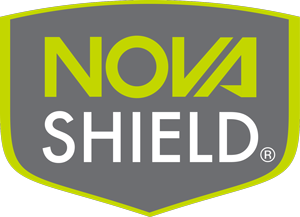LVT 101
Luxury Vinyl Flooring Information
Product and Installation Videos
Installing Rigid Core Luxury Vinyl Flooring
Luxury Vinyl Flooring Tool Review
How to Ensure NovaFloor Luxury Vinyl Flooring is Engaged/Locked
Mistakes to Avoid When Installing Luxury Vinyl Flooring

NovaShield®
Frequently Asked Questions
Q: What is the difference between traditional or Flexible LVT and the new Rigid Core LVT?
A: The main difference between the two is that Rigid Core Luxury Vinyl Flooring includes an extruded polymer-based core layer that gives the flooring a more rigid characteristic. This helps the LVT plank or tile hide some common subfloor imperfections that could transfer or “telegraph” up to the floor’s surface, which can be common with traditional flexible LVT in certain circumstances.
Q: What are the advantages to Rigid Core LVT flooring?
A: The rigid core hides most common subfloor imperfections, making installation easier and ensuring a smoother finished appearance after installation. Rigid Core LVT is also waterproof, so it can be installed in water prone indoor areas, such as bathrooms, kitchens, laundry rooms and entryways. Rigid Core LVT is a floating floor that’s installed with a locking system, so you do not use an adhesive. Also, a rigid core allows for the pre-attachment of an underlayment on some styles that helps soften sound and creates a cushion underfoot. Also, there’s less subfloor prep than with a flexible LVT.
Q: What does “MLF” mean?
A: MLF stands for a category of flooring called “Multilayered Flooring.” That’s essentially any kind of hard surface flooring composed of multiple layers of different material that are assembled together, provided that the middle layer is a polymer-based material.
Q: What are the different types of Multilayer LVT flooring?
A: In the beginning of this new category of LVT, there was “Wood Plastic Core” or “Wood Plastic Composite” (WPC). That is flooring with a polymer-based extruded core that uses wood flour as an ingredient. Then came “Stone Plastic Composite” (SPC). This is a polymer-based extruded core that uses minerals, such as limestone or calcium carbonate, as an ingredient.
Q: What are the similarities and differences between WPC and SPC flooring?
A: All are considered to be Rigid Core LVT, are 100% waterproof and considered dimensionally stable. Also, all are good at hiding some common subfloor imperfections. (With Flexible LVT, on the other hand, subfloor imperfections can sometimes be transferred (or “telegraphed”) to the surface.)
The principle differences are found in the construction of the core:
For WPC, a foaming agent is used to create tiny air pockets in the extrusion process for more comfort underfoot, better acoustical quality and lighter overall weight.
For SPC, there are no air pockets—the core is solid. The product is heavier and dent resistance is greater.
The principle differences are found in the construction of the core:
For WPC, a foaming agent is used to create tiny air pockets in the extrusion process for more comfort underfoot, better acoustical quality and lighter overall weight.
For SPC, there are no air pockets—the core is solid. The product is heavier and dent resistance is greater.
Q: Is a Rigid Core LVT more difficult to cut than Flexible LVT?
A: In a manner, yes. It can still be scored and snapped but will take multiple passes with a utility knife to score, especially with thicker constructions. Use of power saws is recommended; use of a saber saw is best when scribing or making intricate cuts.
Q: Does Rigid Core LVT need special handling or more or less acclimation than Flexible LVT?
A: Careful handling is necessary with all floating flooring to avoid damaging the locking mechanism during transport and moving, etc. Regarding acclimation, please consult the installation instructions for each product as to the specific conditions for storing, transport and installation.
Q: Should I use an underlayment with Rigid Core LVT?
A: No, Additional underlayments are not to be used with flooring that has a factory attached acoustical backing.
Q: Does Rigid Core LVT expand and contract like Flexible LVT? What do I need to know about using transitions and spacers?
A: Consider that Rigid Core LVT expands and contracts at about half the rate of flexible LVT, so plan transitions accordingly. Refer to product installation guidelines if additional information is needed.
Q: What are “common subfloor imperfections?”
A: Common subfloor imperfections include, but are not limited to, minor cracks, pock/spalling marks in concrete, certain grout joints and small deviations in flatness of the subfloor. Complete subfloor preparation requirements can be found in the product installation guide.
Q: If Rigid Core LVT is waterproof, can I use it outside?
A: Rigid core flooring will not be harmed by water when exposed to it from spills and normal cleaning. However use of the flooring outside exposes it to other elements which will damage the flooring and is not covered by your warranty.
Q: Can I use grout with Rigid Core LVT?
A: Rigid Core flooring is designed as a floating floor which does not allow for the application of grout.
Q: Where can I get more information about Novalis® Rigid Core Flooring?
A: There are several places where you can learn more about Novalis®, and NovaFloor®:
1. Ask your NovaFloor® Elite Dealer. The Elite Dealer carries the full line of NovaFloor® products, including Rigid Core LVT made by Novalis® and will give you knowledgeable answers. You’ll find the NovaFloor® Elite Dealer nearest you by consulting our Find a Retailer page at NovaFloor.us.
2. Check out our Tech Info page at NovaFloor.us for the warranty information, installation and care instructions for your NovaFloor® Rigid Core LVT flooring.
3. Send us your questions on the Contact Us page at NovaFloor.us. We’re here to help you!
